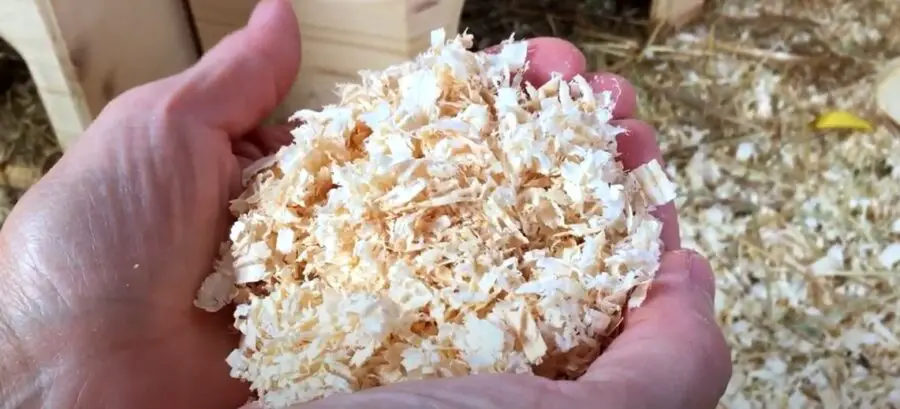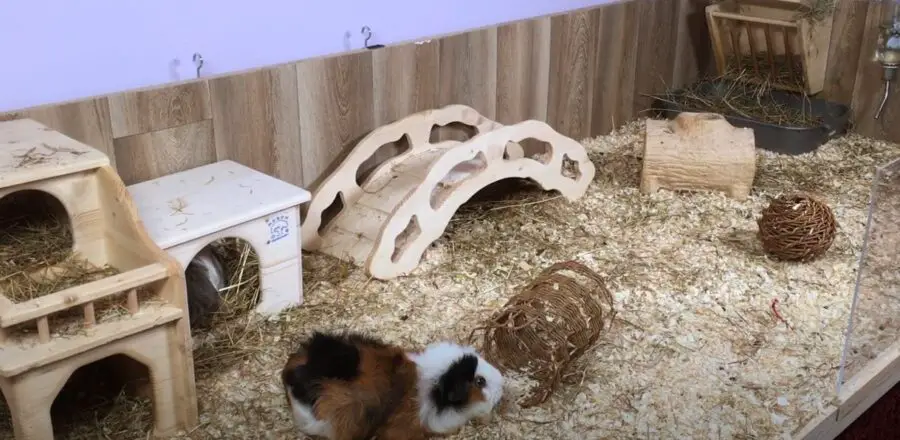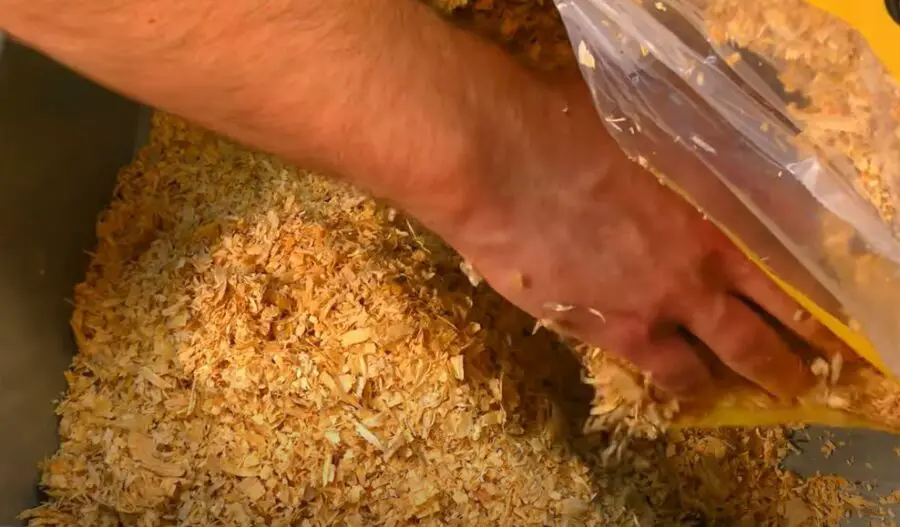I think pine bedding for guinea pigs is a hit-and-miss topic. What do you think? Do you want to know if pine bedding is good for guinea pigs?
It’s important to dive deeper to figure out what kind of pine bedding is good for guinea pigs.
This is why I want to dedicate an article for pine bedding and whether or not it is good for guinea pigs.
Is Pine Bedding Good for Guinea Pigs?
Pine Bedding should be soft, absorbent, but more importantly free of phenols and dust. This is why kiln-dried pine shavings are the go-to option for pine bedding.
Do not simply use untreated pine or cedar shavings as they are harmful, give off aromatic hydrocarbons, phenols that could lead to skin problems, respiratory issues and other illnesses.
If your guinea pig is hairless, avoid all types of wood based bedding and choose anti-pill fleece liners instead for their sensitive and exposed skin.

What Is Pine Bedding?
Pine bedding is what you get when you take shavings from pine wood trees. It is not safe for rodents if used in its untreated form. They are typically the byproduct of pine wood processing.
This waste is converted into a safe form of bedding for our guinea pigs when they are treated in kiln-dried ovens. The reason why pine bedding popular is because it is
- soft
- absorbent
- freshens the enclosure
- cheap
- safe when treated
Pine bedding can reduce any odors that develop in your guinea pig’s enclosure. Unfortunately, too many people have had terrible results when they use untreated forms of pine or cedar shavings leading to respiratory or liver diseases in their cavies.
Always check the product label to make sure it is kiln-dried and you should be assured that this type of pine bedding will be fine for your guinea pig.
Which Bedding Is Bad for Guinea Pigs?
You might be here to find out why some people say that pine is terrible for guinea pig bedding. This is because you have to be more specific about what kind of pine we are talking about.
If we’re only considering pine or cedar wood shavings, they contain chemicals, toxins, dust and phenols that are dangerous for guinea pigs’ respiratory systems and livers. It can lead to diseases and fatal consequences.
Cedar and pine that is untreated in the form of sawdust or shavings is a no-no. Kiln-dried pine shavings that have been treated in large ovens, are free of chemicals and dust and we love using them for our guinea pigs.
The only time we didn’t use kiln-dried pine shavings or aspen shavings was when we had a hairless guinea pig who was very sensitive. We gave her a fleece lining substrate instead.
Note: If you use any type of fabric that is not anti-pilled, then it is easy for rodents to pull on the threads and it will be very unsafe for them to ingest. Anti pill fleece is safe because they can’t pull out the fibers.

Is It Safe If My Guinea Pig Eats Pine Bedding?
Your guinea pig is bound to chew on their bedding from time to time. We noticed bits of bedding or pieces of wood pulp sometimes mixed with their dry poop.
You get to know your guinea pigs when you clean up after them daily. Pine and cedar bedding that is not treated or kiln-dried will damage the liver and respiratory systems of small rodents like guinea pigs.
There are toxins such as phenols that will be very harmful for a guinea pig to digest. If the pine bedding has been treated, heated in large kiln ovens then it should be safe in small portions for your guinea pig to accidentally ingest.
If you find that you have a guinea pig who loves to chew on their own bedding too often instead of hay, it’s better to switch out to a anti-pill form of fleece liners. This tough, but soft fabric is difficult for them to pull, chew and ingest.
How Is Wood Bedding Safe for Guinea Pigs?
Wood bedding or wood shavings are only safe for guinea pigs when they are free of:
- chemicals
- phenols
- aromatic hydrocarbons
- dust
They have to be dust extracted and the most common way of doing so is when they are kiln-dried. Look for any type of wood shavings that are kiln-dried or look for aspen shavings instead of pine and cedar.
If you want to give up wood bedding all together, you can use shredded paper or anti-pilled fleece liners instead for your guinea pigs.
Is Pine Poisonous To Rodents?
Pine shavings that have been treated and processed in the correct way are not poisonous or toxic. Untreated pine contain compounds that are poisonous such as aromatic hydrocarbons that can lead to respiratory and liver problems.
As long as you make sure that the pine you are using is kiln-dried. Then you can be sure that it has been treated as dust free and chemical free.
Pine bedding is:
- highly absorbent
- smells fresh
- cheap
- antibacterial
- easy to clean up
- mimics the natural substrate of guinea pigs in the wild
When the pine shavings are kiln dried, they work very well to neutralize any odors that can develop from the poop or urine of your guinea pig. It is usually priced cheaper than aspen shavings or other high-end bedding products.
Guinea pigs are often found in the wild on pieces of leaves or straw. Pine shavings mimic that feeling for them underneath their feet.

Why You Shouldn’t Use Pine Bedding
Sometimes pine bedding that is sold commercially is not intended for rodents. They can be too rough or sharp. It can lead to injuries.
They might be untreated and filled with phenols or other chemicals. Finally this type of pine bedding could be dusty.
Make sure that pine bedding is not rough, sharp or contains dust. This is easy when the pine bedding is treated and kiln-dried.
If you would like to check out the best bedding for guinea pigs article we wrote, check it out right here.
Pine Or Aspen Bedding For Guinea Pigs?
In its natural state, aspen bedding is better for guinea pigs. It doesn’t need to be processed as much as pine or cedar to become safe.
Aspen is naturally dust free because it is a form of hardwood. It can be recycled and used for a longer period of time. Aspen shavings are usually priced slightly higher.
You can get the same results with comfortable, absorbent and odor-free pine bedding that is kiln-dried.
Benefits of Pine Bedding
If pine bedding has been processed and treated, meaning that it is kiln-dried, guinea pigs or other rodents and even rabbits can have a lot of fun with it.
They can roll around, build nests or tunnel through it. This type of bedding keeps your favorite pocket pet companions dry and comfortable. The scent is fresh and absorbs odors well.
You can also use pine shavings as mulch in your garden. It doesn’t decompose very well so we do not recommend using pine bedding in your compost.
When using pine bedding in the garden, it helps to keep a lot of pests like slugs or other insects away. It is a type of natural insecticide.

What Is The Best Guinea Pig Bedding?
I know it’s a weird answer, but I have to say that you should let your guinea pig tell you what their favorite bedding is. You can try fleece liners that are anti pilled which are safe because they don’t allow the tightly woven fabrics to be pulled, torn and ingested.
If your guinea pig is hairless, they are more sensitive to skin irritations when coming into contact with wood based bedding options. It doesn’t hurt to try out the different options and see how you feel about it and how your guinea responds.
Anti-pill fleece liners are easy and safe. You will have to wash them weekly and it depends on how you feel about that. Paper bedding needs constant replacing.
Pine or aspen shavings mimic their natural substrates in the wild and work well when they are free of dust or harmful chemicals like phenols. Kiln dried pine shavings is a type of bedding we stand by, but we don’t have to tell you what is the best. You and your guinea pigs will find that out soon enough!
Is Cedar Bedding Good for Guinea Pigs?
No. Since cedar is very aromatic, dusty and contains hydrocarbons like phenols, we don’t recommend that you use them as bedding for your guinea pigs. The dangerous oils within it needs processing, heating and treating to make them safe.
Aspen shavings are a better source of wood because it’s already a hardwood that doesn’t contain these oils. Hairless guinea pigs or those with sensitive skin will benefit from softer bedding instead.
If your guinea pig is recovering from an ailment or has stitches, never use wood based bedding that isn’t soft and treated. Fleece liners that are in anti-pill form are a better and softer option.
Thank you for visiting PocketPetCentral.com for the best information to help you enjoy the life of your pocket pet companion in a fun, safe & healthy way.


